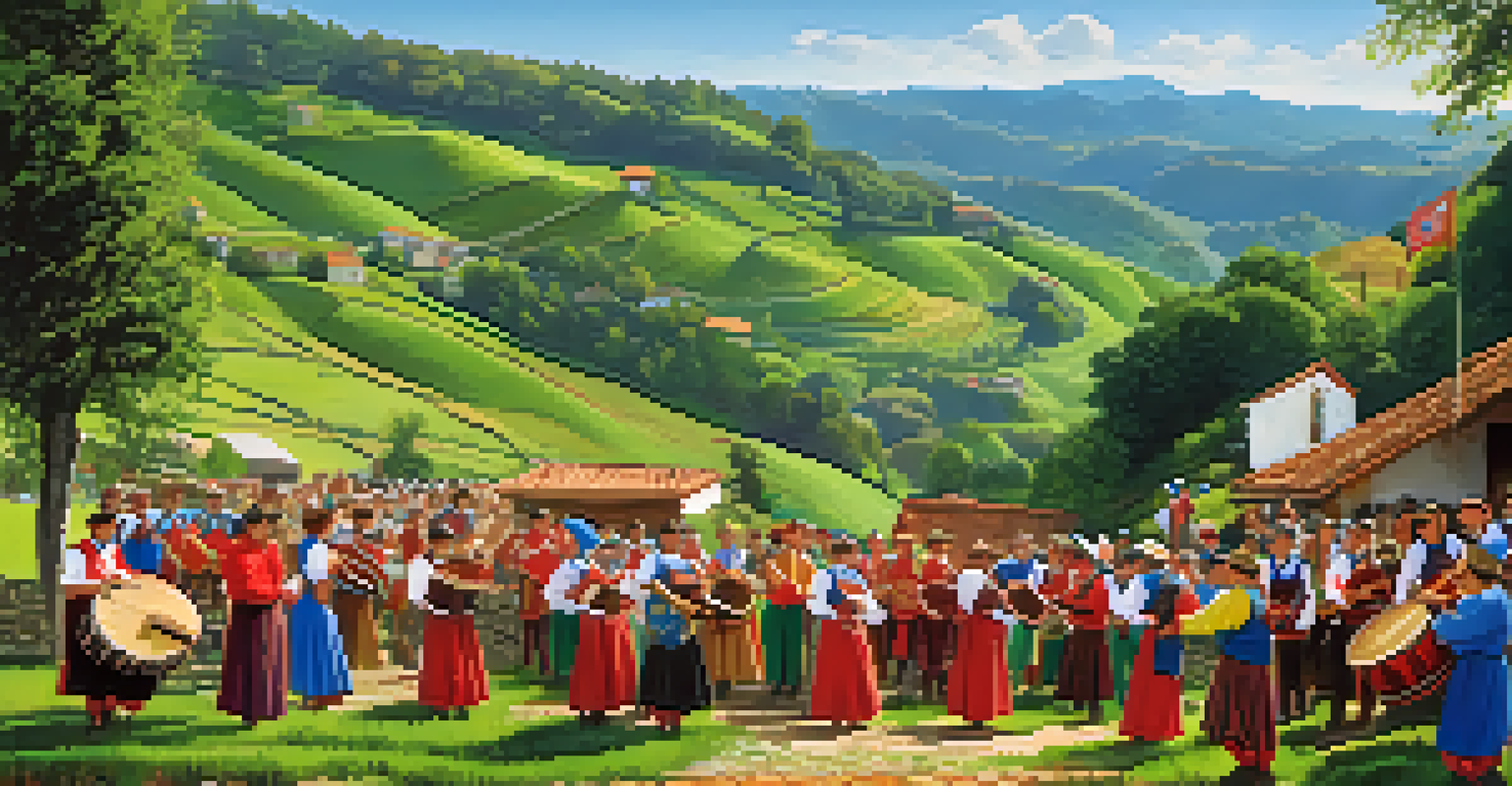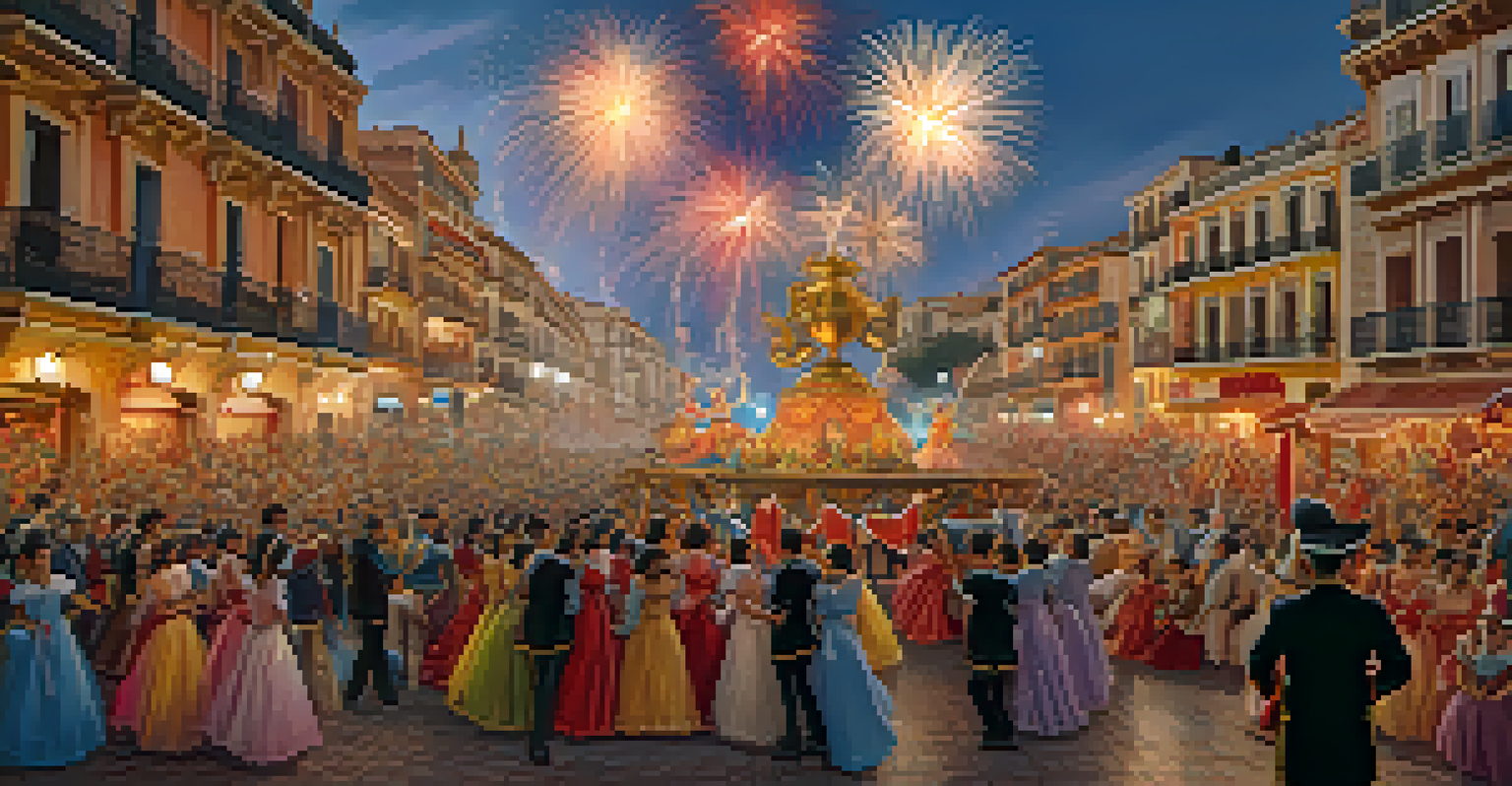Regional Variations: The Sounds of Spanish Folk Music

Understanding the Roots of Spanish Folk Music
Spanish folk music is rich with history, reflecting the diverse cultures that have influenced the country over centuries. From the Moorish rhythms to the Celtic melodies, each region has contributed its unique sound. This blend creates a musical tapestry that showcases the stories and traditions of the people.
Music is the shorthand of emotion.
The roots of this music can be traced back to ancient times when communities used songs to express their daily lives, joys, and sorrows. Instruments like the guitar, castanets, and bagpipes became synonymous with Spanish folk music, each adding its flavor to the mix. Understanding these roots helps us appreciate the depth and emotion behind the melodies.
As we explore regional variations, it’s essential to recognize how geography and history shaped these sounds. The mountains, coasts, and plains of Spain all influence how music is created and performed, making each region's folk music distinct and vibrant.
The Flamenco: Soul of Andalusia
When we think of Spanish folk music, Flamenco often comes to mind, epitomizing the spirit of Andalusia. This passionate art form combines singing, guitar playing, and intricate footwork in a stunning display of emotion. It's not just music; it's a way of life that tells the story of the Andalusian people.

Flamenco's roots can be traced back to the cultural blend of Gypsy, Moorish, and Jewish influences. The unique sounds of the guitar, alongside the powerful vocals, create an atmosphere that captivates audiences worldwide. Each performance is a personal expression, making it ever-changing and dynamic.
Diverse Roots of Spanish Folk Music
Spanish folk music is a rich tapestry woven from various cultural influences, each region contributing its unique sounds and stories.
While Flamenco is celebrated globally, it remains deeply connected to its Andalusian origins. Festivals, gatherings, and local performances help keep this tradition alive, passing it down through generations while continuously evolving.
Asturian Folk Music: A Celtic Influence
In the northern region of Asturias, folk music showcases a strong Celtic influence, setting it apart from other Spanish styles. The use of instruments like the gaita (a type of bagpipe) and the tambor (drum) creates a distinct sound that resonates with its lush landscapes. This music often serves as a backdrop for traditional dances and celebrations.
Without music, life would be a mistake.
Asturian songs frequently tell tales of the sea, mountains, and the everyday lives of its people. The themes often reflect a deep connection to nature and heritage, inviting listeners to experience the beauty of the region. Community gatherings often feature these songs, fostering a sense of belonging.
As globalization impacts music worldwide, Asturian folk music is adapting while retaining its essence. Young musicians are blending traditional sounds with modern influences, ensuring that this unique style continues to thrive and evolve.
Galician Traditions: The Sound of the Sea
Galicia, located in the northwest of Spain, boasts a rich tradition of folk music deeply intertwined with its maritime culture. The sounds of the sea echo throughout Galician music, often featuring instruments like the gaita and the pandeireta (a type of frame drum). This connection to the ocean is reflected in the stories and themes found in their songs.
Galician folk music is characterized by its haunting melodies and lively rhythms, often accompanied by traditional dances. Festivals like the Festa dos Maios celebrate this music, bringing communities together to honor their heritage. The infectious energy of these gatherings highlights the importance of music in Galician culture.
Flamenco: Heart of Andalusia
Flamenco embodies the spirit of Andalusia through its passionate blend of singing, guitar, and dance, reflecting the region's cultural heritage.
As the world evolves, Galician musicians are finding ways to modernize their folk traditions while staying true to their roots. Collaborations with contemporary artists are breathing new life into these age-old sounds, ensuring that Galician folk music remains relevant for future generations.
The Impact of Castilian Folk Music
Castilian folk music, originating from the central region of Spain, is often recognized for its simplicity and heartfelt lyrics. It serves as a reflection of the daily lives and struggles of the people, often sung during festivals and social gatherings. Instruments like the flute and guitar create a melodic backdrop for storytelling.
One of the most notable aspects of Castilian music is its emphasis on community. Music is an integral part of celebrations, from weddings to harvest festivals, fostering unity among participants. The songs often evoke a sense of nostalgia, connecting listeners to their cultural heritage.
In recent years, Castilian folk music has seen a resurgence, with younger generations showing renewed interest. Efforts to preserve and promote traditional sounds are helping to keep this vibrant culture alive while integrating new influences.
Valencian Folk Music: A Festive Celebration
Valencian folk music is a vibrant expression of the region's rich cultural heritage, often characterized by its lively rhythms and festive atmosphere. Known for its powerful brass bands and traditional dances, this music is a staple at local celebrations such as Las Fallas and La Tomatina. The joyous nature of Valencian music invites everyone to join in and celebrate.
At the heart of Valencian folk music is the dolçaina, a traditional woodwind instrument that produces a bright, cheerful sound. This instrument, along with the tabalet (a type of drum), creates an infectious rhythm that gets people dancing. The combination of music and dance is a vital part of community festivities, bringing people together in celebration.
Evolving Folk Traditions
As globalization continues to influence music, Spanish folk traditions are adapting while retaining their essence, ensuring their relevance for future generations.
As Valencian folk music continues to evolve, contemporary artists are exploring new ways to incorporate modern influences while honoring traditional sounds. This fusion keeps the music fresh and engaging, ensuring its place in the rich tapestry of Spanish folk traditions.
Catalan Folk Music: A Blend of Cultures
Catalonia's folk music reflects the region's diverse cultural influences, merging elements from its Mediterranean neighbors and beyond. Characterized by its lively rhythms and unique instruments like the gralla (a type of woodwind) and the tabal (drum), Catalan music is both festive and deeply rooted in tradition. This rich musical heritage is celebrated during local festivities, showcasing the region's identity.
One of the most iconic events in Catalonia is the Sardana, a traditional dance performed in a circle, accompanied by lively music. This dance emphasizes unity and community, inviting people of all ages to participate. It reflects the Catalan spirit of togetherness, making it a cherished cultural practice.

As Catalonia faces modern challenges, its folk music continues to adapt while staying true to its roots. Contemporary musicians are exploring new sounds and styles, ensuring that Catalan folk traditions remain vibrant and relevant in today's world.
The Future of Spanish Folk Music
The future of Spanish folk music looks promising, as artists and communities strive to keep their traditions alive while embracing modern influences. Folk festivals across the country serve as platforms for both traditional and contemporary musicians, fostering a sense of unity and celebration. This blending of old and new creates an exciting space for innovation.
Young musicians are increasingly experimenting with different genres, incorporating elements of pop, rock, and world music into their folk roots. This evolution not only attracts a wider audience but also ensures that folk music remains relevant in a rapidly changing cultural landscape. It's a testament to the enduring nature of these traditions.
As we look ahead, it’s crucial to support and promote the preservation of Spanish folk music. By valuing these rich cultural expressions, we can ensure that future generations continue to enjoy and celebrate the diverse sounds of Spain, keeping the spirit of its folk traditions alive.